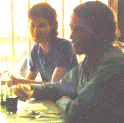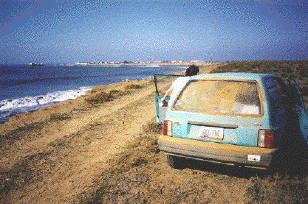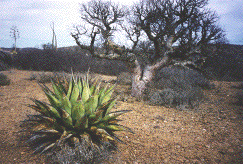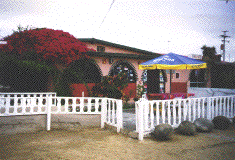Written 2001


Note from 2021: This article is from a Mexico trip we made about twenty-one years ago, one of our very first. It was all quite new to us. A lot of that details that seemed so fascinating then are now – after having at last traveled to every Mexican state – somewhat ordinary. Still, I think the articles are interesting.
Apologies for the poor quality photos. They were uploaded at a time when I thought that GIFs were quite acceptable for photos!
:+:+:+:+:+:+: Our trip through Baja California was full of surprises :+:+:+:+:+:+:
TECATE AND THE WINE COUNTRY
We had favorable impressions of the first town on our itinerary, Tecate. Tecate, like several border towns has a sister town across the border. In the case of Tecate, California, however, “town” is too kind. Lets just call it a clump of buildings that exists mainly for the border crossing.
We had to pay $33 for a car permit at the Bital bank. This bank was in a building not much bigger than a broom-closet. A skinny young man behind the counter for the longest time went about his business and didn’t so much as nod to us or acknowledge our presence. Finally, after a long wait and well after my eyes had glazed over (It had already been a long trip; we had left Tucson that morning) I heard him try to get my attention, “Hell-ooo, sir…your papers….wake up.” My wife had heard him say in Spanish to a lady behind him, “Well, I better take care of these gringos.” Well, I wrote more about this incident than I intended. I guess rudeness pushes one of my buttons. But most of the people we met were more civil.
We were soon on our way and driving in a foreign country for the first time (unless you count Canada, which is not a foreign country. Everyone knows that). Here is a warning about driving in Mexico: stop signs (“alto”) are not always clearly marked. Usually, but not always, “alto” is painted on the road before the stop. Another detail: traffic lights are often not very bright. I was blared at by a truck behind me in Ensenada because I mistook the light shining on the red light for the actual signal. The green light was weak. Another confusing feature is the misplaced location of lights; you may have a red left-turn light right in front of you and your green light is off to the right.
Highway 3 took us through downtown Tecate. The park (was pleasant to look at, except for the huge statue of an angry looking dude glaring at the pigeons (“Don’t even THINK of it!”). He is probably angry because he has no body. Mexico seems to like big statues and memorials.
On our way back we stayed overnight here (the town… not the park). The modern Okakopa Iwa Hotel was where we stayed on our last night in Baja. It is in fact one block from the US of A. After a few hours of sleep roosters boisterously greet the dawn at 2 AM. “Lets get up!”, my wife nudged me, “The roosters are crowing. That means its dawn.”
Back to our first day. The road to Ensenada winds through picturesque and hilly wine country that reminds me of central California. We couldn’t fully appreciate the scenery that first day on our way down this road because potholes often demanded our attention. Shadows were starting to lengthen over the road and we definitely didn’t want to be driving this stretch at night.
ENSENADA AND MANEADERO
Street signs in Ensenada are poorly marked. Often they are not marked. The only thing that kept me oriented was the huge flag to my left (the largest Mexican flag – 350 feet long. It could be used for a tarp for three football fields end to end). This is at the malecon (waterfront promenade). Locals and a few tourists walk up and down this pleasant parklike area. Pelicans, gulls, cormorants and ospreys can be seen here. Two blocks north of here is Avenida Lopez Mateos, where tourists can be seen buying those valuable sarapes and practising their Spanish. Most of the businesses here are pricey hotels, liquor stores, bars and souvenir stores for those who have more dollars than sense. Nearby is the Cultural Center a beautiful whitewashed ornate structure that is lavishly landscaped. The nooks and crannies are well-worth exploring. This used to be a casino until the repeal of prohibition made this venture less profitable.
We stayed at Hotel Joyamar a little south of downtown. The room was very comfortable and quaint-looking. From the bathroom (if you stand on the toilet) you had a view of the cement wall which had a view of the sea. A block or two away was a well-known restaurant, Cuevo de Los Tigres. The seafood here was delicious and the view of the sea was very relaxing. This is what vacations are made of. Other than some loud Americans trading fish stories, we had the restaurant to ourselves.
If you are planning on driving down here, beware of “topes”! (Speed Bumps) They may or may not be a warning beforehand and they can be very vicious to your car. Another driving note: drivers who want to tell you that can pass them will signal you by blinking their left-turn signals.
SAN QUINTIN
The guide books sometimes omit important details that can make a big difference. Here’s a detail for you: The road to the beach is a bone-jarring affair. A restaurant that I can especially recommend and that it is well-known to many tourists is Mision Santa Isabel – a good place for authentic or gringo food. Menus are in Spanish and English: This is the only place I know that offers “jam omelette”. (Actually, they meant “ham”).
Our favorite hotel this entire trip was Motel San Carlos / Muelle Viejo (“old pier”). Just $20 gave us a comfy room with a back door that opens on to the bay. Not as many amenities as some might expect (No phone in the room, nor TV and the generator is turned off at midnight so there is no electricity until the morning) but the setting is so relaxing that we didn’t mind these minor hardships.


Clean car, dirty car. On the left is the road from San Quintin to the sea, straight west (sort of). On the right is the equally dirt road to Punto Francisco near Camalu. A semi-submerged wreck is viisible on the left. And I thought I had a hard time getting here! These views can be enlarged.
EL ROSARIO
Mama Espinoza’s Restaurant is in all of the guidebooks. I had to order the lobster burrito. The food was good enough (the salsa was especially enchiloso) but the place had a somewhat kitschy tourist ambience. I felt like the deep-sea diver dummy was going to bum me for some of my food. The meal was overpriced, I felt, but part of the money goes to a local orphanage – a children’s home I think.
BOOJUMLAND
Cirrios (boojums) look like some kind of Dr. Suess creation. We start to see them shortly after we ascend out of canyons south of El Rosario. Here we also see Candlabra, Organ Pipe, Saguaro, Old Man and Cardon cactuses. A little further south we start to see Elephant trees, which look like miniature Baobab tree with papery bark like our birches which readily peels off in thin layers.
This stretch from El Rosario to Guerrero Negro has some of the most desolate scenery that I have ever seen – and I’ve been all over our Southwest. Some parts were spectacular, like the Field of boulders, with boojums and cardons densely sprouting all over miles and miles of giant boulders. Other parts are just plain boring, where the vegetation becomes very sparse. The only thing keeping us awake was the white-knuckle zigs and zags of the road. There are no shoulders to most of this road, not even a soft shoulder. Many of the dangerous turns have no guardrail or warnings (unless you count the white crosses of those who have gone before).
You can’t always tell what town you are coming to because there are not many signs telling you. The most common sign we saw was the Tecate signs that marked the existence of a place to eat, however humble. Cafes on this stretch are few and far between, though.
Elephant tree, Agave, Boojums

Agave and elephant tree can be seen here with two boojums in the background.
CATAVINA
Hotel Pinta: Howard-Johnson meets Taco Bell. Nuff said. The gas is for hotel patrons only. There are two arroyos worth exploring, one at either end of town. Both are marked “vado” which means “ford”. We walk up and down the shady canyon of the southern one. Palm trees (native Washingtonians as well as introduced date), boojums and cardons make this a very picturesque oasis to spend some time.
JESUSMARIA
The name of the town sounds like a prayer and ours were answered ; here we finally came across a gas station…and they had gas, too! We had traveled about two hundred miles since we last saw an open gas station.
GUERRERO NEGRO
This region seems to me like it is at the end of the earth. Maybe Punta Arenas at the tip of Chile is like this. The land is flat and sparsely vegetated. Shortly before entering town we cross the border to the southern Baja state, Baja California del Sur. At the border we cross under a stylized eagle (It looks more like a giant tuning fork) and the yet another military checkpoint. They ask (again) if we have any fruit and then (after fair warning) proceed to fumigate our car for something or other.
The town has two main reasons for being: Whales and Salt. The whales hadn’t come in yet (It is only early November) but it is always the season for salt. On our way to look for shorebirds we take a wrong turn and see the evaporative ponds for the salt works. Pickup truckloads of workers pass us by. At the military checkpoint to the works (Those military seem to be everywhere!) we turn around. A sign on the wall warned against drug abuse at the workplace.
In a disgusting recent development, the Mexican government is planning to work with an American firm to convert a good chunk of the whale’s breeding grounds into more salt ponds.
Back in town we look for a restaurant. El Figon de Sal was that was still open. The food was very good. “Why do you always order the combination plate? You are so original.” she tsked. “Try this salsa”, I countered. “It has strange spices or something. A very unique taste.” “Its gone bad, Tom! Don’t you have any tastebuds left?” A guess she was right. She ordered pescado al mojo de ajo (a fish dish served in a delicious garlic sauce). I enjoyed better, if more gringoized food, the next morning at Malarrimo. To be sure, they have lots of Mexican food, I was just hungry for a ham omelet. The place has definitely seen its share of Americans. While we were eating to the strains of “Have yourself a Merry Christmas” hummingbirds were darting outside around the Bougainvillea.
We stayed at Las Ballenas, a small hotel with fifteen rooms. In front of our room was a whale rib and a pelvis. Bougainvillea and other flowers made the whole place very pleasant. The office buildinglet was likewise painted with flowers. On the wall “Welcome” was cheerfully misspelled in seven languages. (I don’t think the Italians need a “y” to say it in their language.)

Hotel Malarrimo in Guerrero Negro had delicious food. Unfortunately, gringo food, but we decided to stay and eat to the strains of “I’m Dreaming of a White Christmas”.
————————–
